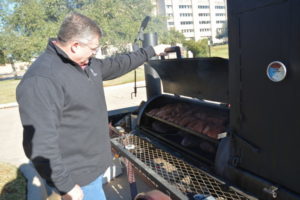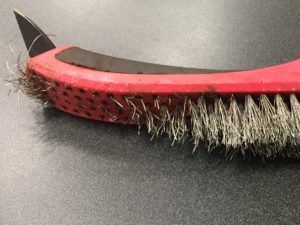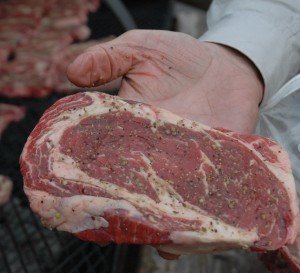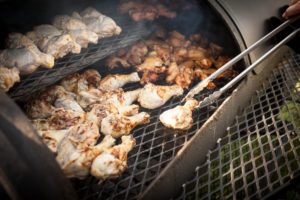Food safety tips when grilling, cooking outdoors
Proper cleaning is key to avoiding foodborne illness from grate to plate

Cleaning grill grates, keeping a clean workspace, and properly storing and preparing meats are all important to maintaining food quality and avoiding foodborne illness, said Texas A&M AgriLife Extension Service experts
A clean grate is a great start
Davey Griffin, Ph.D., AgriLife Extension meat specialist in the Department of Animal Science of Texas A&M University, said cleaning the grill grate is not as simple a proposition as it may seem.
“A lot of people think scraping the grate clean with a wire brush is an effective way to clean it, but if you’re using a substandard wire brush some of the metal particulate can get transferred on the grate, into the food and then ingested,” he said. “This can cause some serious health problems.”
Griffin said using a nylon brush on a cool grate can be an effective measure in removing most of the large pieces of charred food from the grate.
“You don’t want to use a nylon brush on a hot surface as it could melt the bristles,” he said.
Griffin said the grates of smaller grills can be removed and washed with soap and water or possibly power washed if the equipment is available.

“Another effective way to clean grates is to ball up a piece of aluminum foil to where there are still some rough edges and use that to thoroughly scrub the surface,” he said. “I’ve also known people to cut an onion in half and use the flat surface of the onion to clean the grate. The onion has an acidic content that helps break down the leftover food and will also add a little more flavor to the item being grilled.”
Griffin said meat should always be cooked to the recommended internal temperature. He said. using a properly calibrated meat thermometer is the best way to ensure meats are adequately cooked.
“You also want to make sure the grilling surface is sufficiently hot before you place any meat or vegetables on it,” he said. “An easy way to determine that is to hold the palm of your hand about 6 inches over the grate. If you feel it is warm enough for you to want to remove it after a few seconds, then the grill is ready to use.”
Griffin noted there are also a number of safety steps that can be taken to lower the risk of starting an unwanted fire while grilling.
Properly clean your food prep workspace
The most common type of food safety-related issue when grilling is the possibility of foodborne illness from inadequately stored or undercooked foods, said Jenna Anding, Ph.D. AgriLife Extension nutrition specialist in the Department of Nutrition and Food Science at Texas A&M.

“It’s important to keep a clean workspace and ensure meats are properly stored and prepared,” Anding said. “And it’s important to maintain food quality and freshness by ensuring proper temperatures during storage and cooking.”
She said poultry, fish, seafood or ground beef should be cooked or frozen within a day or two of purchase. Steaks or pork chops should be cooked or frozen within four to five days.
“The safest way to thaw meat or poultry is by placing it in the refrigerator a day or two before you plan to cook it,” she said.
She said some meats defrosted in the microwave may not thaw out evenly and other parts of the food may be partially cooked, so it’s better to let them thaw in the refrigerator.
“Don’t thaw meats at room temperature as this may increase the chance of foodborne illness.”
If cooking away from home and not sure about a water source, take a container of fresh water and paper towels or use antibacterial towelettes or hand sanitizer, Anding said.
“Be sure to wash hands before and after touching raw meat, poultry or seafood, making sure food preparation surfaces, cutting boards, grilling utensils and serving platters are washed and sanitized. And if you’ve placed raw meat or fish on a platter before grilling, don’t use that same plate to serve the food unless it can be cleaned with hot, soapy water first.”
Recommended food temperatures
Anding said poultry should be cooked to an internal temperature of 165 degrees.

“Fully cook meats like hot dogs to 165 degrees and hamburgers to 160 degrees,” she said. “Beef, pork, lamb, veal steaks, chops and roasts should be cooked to at least 145 degrees. For safety and quality, however, allow these foods to rest for a few minutes after removing them from the grill before serving.”
After cooking, Anding said, be sure to keep the food hot until it is served — at least 140 degrees — otherwise, eat or refrigerate it right away.
“Keep food covered and never let it sit out for more than two hours,” she said. “If the weather is 90 degrees or hotter, eat or store your food within one hour.”
For additional information, go to the U.S. Department of Agriculture’s Food Safety and Inspection Service fact sheet.
-30-
Via source, AgriLife Today | Food safety tips when grilling, cooking outdoors